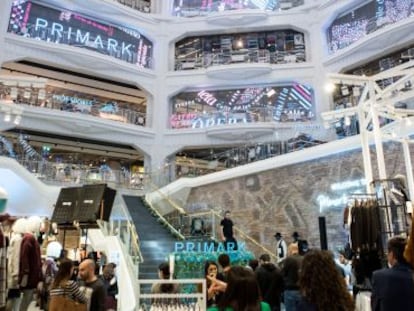What’s hiding behind those long lines at Primark?
The Irish low-cost clothing retailer has found its second-biggest market in Spain
The long lines forming at Gran Vía 32 in Madrid to enter the low-cost retailer Primark’s flagship store have been generating worldwide publicity.
Even the satirical website El Mundo Today recently ran a story about the crowds gathering at the Irish-retailer: “Primark closes after it finishes dressing every single Spaniard,” the headline read. Some people have been coming up with their own hashtags on social media about the avalanche of shoppers.
While many have just discovered Primark’s very low prices, the 12,400-square meter store – the chain’s second largest in the world – is actually the Irish retailer’s 41st in Spain. It opened last month with much fanfare – and huge crowds.
The crisis hit harder here than in northern Europe and low-cost prices are very attractive ” IESE business school professor Julián Villanueva
In fact, there are more Primark stores in Spain than in Ireland, where the clothing store first got its start in 1969.
In 2001, Julián Villanueva, a professor at the IESE business school in Madrid, published a study about the brand name and continues to follow its evolution. According to Villanueva, the love between Primark and Spaniards is down to many factors.
“On one side, the crisis has hit harder here than in the north of Europe, and low-cost prices are very attractive,” he says. “The recession has also helped in its growth because Primark needs very large stores, which have been easy to find over the past few years.”
At the same time, store owners discovered that Spanish consumers, accustomed to bargain prices at Zara and Mango, are well aware and very fond of the “fast fashion” concept.

“Inditex [parent company of Zara and a host of other fashion brands] has done a great job in removing the stigma that many of these cheap labels may have had. Buying at Primark is more acceptable than in other markets,” Villanueva explains.
Even though they are vying for the same consumers, Primark’s business model greatly differs from its biggest competitors: Inditex and H&M.
“They are the Lidl of fashion,” says Gerard Costa, marketing professor at Madrid’s ESADE business school, in reference to the German-owned supermarket chain.
“They attract a lot of people but their profit margin is very low. The average price for a woman’s dress is €6 while at H&M the same dress goes for €15,” says Costa, who is also tracking the Primark phenomena.
Because prices ranges do not fluctuate between high and low – everything is low at Primark – consumers are not concerned about the cost and tend to buy more each time they visit the store.
“Sales by square meter at H&M round off to about €3,200, while at Primark, they are about €5,000 per square-meter,” Costa said.
The typical Primark client buys more for their household, and sometimes it is the only place where they shop.
“More than 50% of shoppers that go to the store at Illa Diagonal in Barcelona only go to Primark and don’t visit any other stores at the mall. And the ones who visit other stores don’t go to Primark,” he says.
Consumers know that the quality of the clothing isn’t the best, but it’s cheap
Consumers know that the quality of the clothing isn’t the best, but it’s cheap. Primark is able to sell at low prices because it invests little in fashion design and materials, and the shopper is aware of this, according to studies carried out by ESADE marketing students.
The concept comes from the United States, where more customers are buying clothes that they will only wear a few times.
Limited durability is also key factor in Primark’s strong sales in baby clothes. Maybe those €3 blue jeans may not be the best on the market but by the time the stitching wears out, the infant will have already grown out of them.
English version by Martin Delfín.
Tu suscripción se está usando en otro dispositivo
¿Quieres añadir otro usuario a tu suscripción?
Si continúas leyendo en este dispositivo, no se podrá leer en el otro.
FlechaTu suscripción se está usando en otro dispositivo y solo puedes acceder a EL PAÍS desde un dispositivo a la vez.
Si quieres compartir tu cuenta, cambia tu suscripción a la modalidad Premium, así podrás añadir otro usuario. Cada uno accederá con su propia cuenta de email, lo que os permitirá personalizar vuestra experiencia en EL PAÍS.
¿Tienes una suscripción de empresa? Accede aquí para contratar más cuentas.
En el caso de no saber quién está usando tu cuenta, te recomendamos cambiar tu contraseña aquí.
Si decides continuar compartiendo tu cuenta, este mensaje se mostrará en tu dispositivo y en el de la otra persona que está usando tu cuenta de forma indefinida, afectando a tu experiencia de lectura. Puedes consultar aquí los términos y condiciones de la suscripción digital.
More information
Últimas noticias
Trump claims peace in Ukraine is near, but Moscow suggests otherwise
A survivor’s account of the Interoceanic Train accident: ‘We were scared because of the speed on the curve’
The Interoceanic Train, the Mexican alternative to the Panama Canal
What is known about the Interoceanic Train derailment in Oaxaca
Most viewed
- Oona Chaplin: ‘I told James Cameron that I was living in a treehouse and starting a permaculture project with a friend’
- Reinhard Genzel, Nobel laureate in physics: ‘One-minute videos will never give you the truth’
- Why the price of coffee has skyrocketed: from Brazilian plantations to specialty coffee houses
- Pablo Escobar’s hippos: A serious environmental problem, 40 years on
- Chevy Chase, the beloved comedian who was a monster off camera: ‘Not everyone hated him, just the people who’ve worked with him’










































